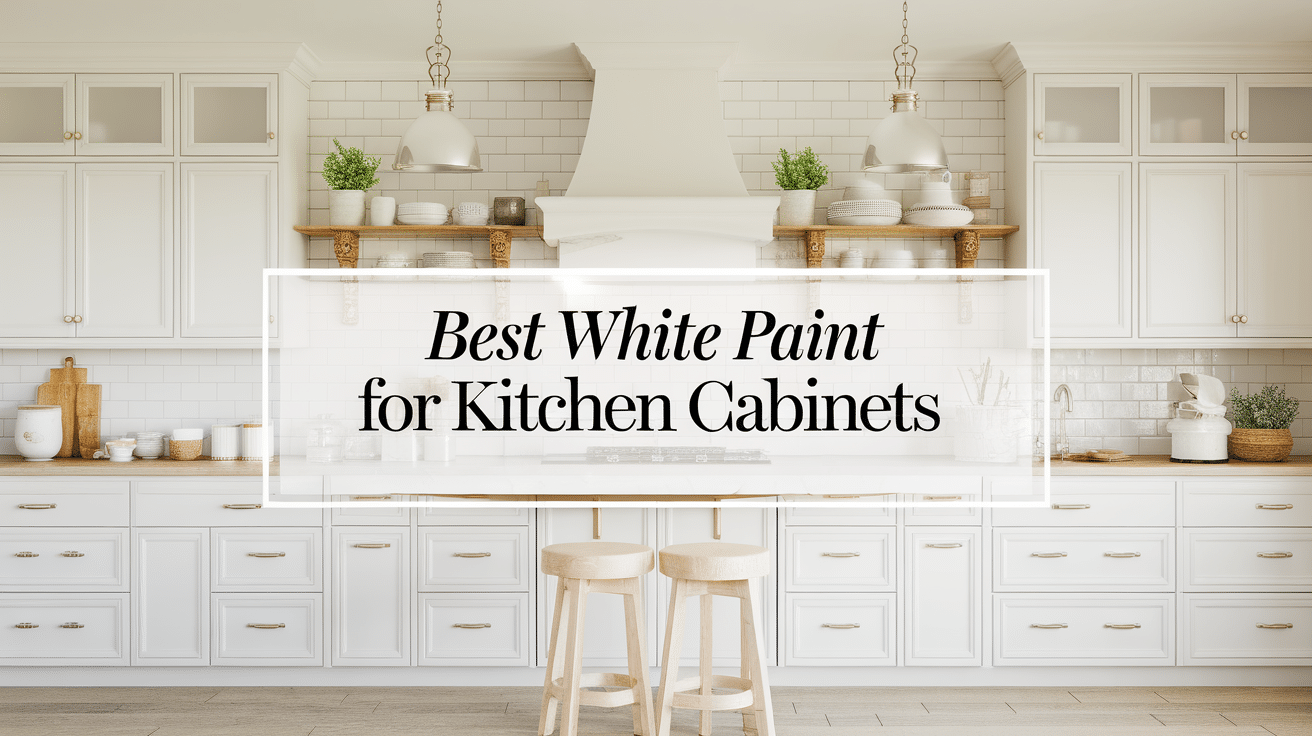White paint might look simple, but it can quickly change the feel of your kitchen. It can make cabinets look clean, fresh, and brighter—sometimes even newer. Picking the right shade of white is one of the easiest ways to improve the whole space.
But choosing the right white paint isn’t always easy. There are cool and warm tones, subtle undertones, and finishes to consider. Some paints can look too bright in sunlight or too dull under kitchen lights.
That’s why it helps to have a clear list to start with. In this post, you’ll find trusted white paints that many homeowners and designers already use. I’ll also share helpful tips about undertones, lighting, and finishes to make your decision easier.
Use this guide to save time, avoid mistakes, and find a white paint that truly works for your kitchen.
Best White Paints for Kitchen Cabinets
White paint can change the way your kitchen feels without needing a full remodel. But not all whites are the same. These four options are well-known and loved for good reason—they work in many kitchens and give a clean, lasting look.
1. Benjamin Moore’s White Dove (OC-17)

White doves are soft and warm. Its slight gray undertone makes it look calm and easy on the eyes. It works well in kitchens with lots of light or darker wood.
This paint doesn’t feel too bright or too creamy. It’s a good choice if you want your cabinets to look clean but not cold. Many people say it looks balanced no matter the time of day.
White Dove goes with many colors. It works with warm tones like beige or cooler grays, too, making it easy to fit into an existing kitchen style.
It’s also a favorite for older homes. It adds a gentle touch without changing the room’s feel. If you’re unsure where to start, this is a safe pick.
2. Sherwin-Williams’s Alabaster (SW 7008)

Alabaster has a creamy base that feels calm and inviting. It’s not too yellow and not too stark. Many designers use it in kitchens for a soft and cozy look.
It pairs well with wood accents, stone counters, and light floors. This paint makes the space feel warm without being heavy. If you want a lived-in look, this is a solid option.
Alabaster looks great under both natural and indoor lights. Its tone stays steady without changing too much, making it a smart pick for kitchens with mixed lighting.
This color is often used in farmhouse and cottage-style homes, but it also works in newer builds with neutral tones. It gives a relaxed yet polished feel.
3. Benjamin Moore’s Simply White (OC-117)

Simply White is bright and clean. It has a bit of warmth, so it doesn’t feel too sharp. It’s great for small kitchens where you want more light.
This paint looks fresh and crisp next to stainless steel and white tile. It helps your kitchen feel bigger and more open. It also pairs well with both warm and cool accent colors.
White is one of the most used colors by designers. It often appears in magazines and model homes. That’s because it gives a clean look without being too cold.
If your kitchen gets a lot of natural light, this paint shines. It reflects the light well and helps brighten the space. It’s also easy to match with walls, trim, and ceiling paint.
4. Sherwin-Williams’s Pure White (SW 7005)

Pure White is simple and easy to work with. It’s not too warm or too cool, which makes it a flexible option. It gives your kitchen a neat and fresh finish.
This color is good for both modern and classic kitchens. It blends well with other whites, grays, and even bold colors. It gives a clean backdrop without stealing the spotlight.
Pure White holds up well under different lighting. It won’t shift in color too much, even as the sun moves. That means what you see in the morning is close to what you’ll see at night.
Many homeowners love it for its clean look and low risk. It makes your cabinets feel new without standing out too much. It’s a great middle ground if you can’t decide between warm and cool whites.
5. Benjamin Moore’s Chantilly Lace (OC-65)

Chantilly Lace is one of the brightest whites you can pick. It has almost no undertones, which makes it look very clean and sharp. It works well if you want a crisp, modern kitchen.
This paint is best for kitchens with lots of natural light. It reflects light and makes the space feel bigger and fresher. It pairs nicely with white marble, chrome, or light wood tones.
If your kitchen has cooler tones, this color will match easily. It doesn’t lean toward yellow or gray, so it stays neutral. That makes it a safe pick for walls, cabinets, and trim.
Some people say it can feel too bright in low-light rooms. If your kitchen is small or dark, test it first to be sure. But in open, sunny spaces, it really shines.
6. Sherwin-Williams’s Snowbound (SW 7004)

Snowbound is a soft white with a slight gray-pink undertone. It adds a gentle touch to your cabinets without looking too warm or too cold. This color works well in both modern and traditional kitchens.
It’s a good fit for kitchens with soft wall colors or wood floors. Snowbound helps create a calm and balanced space. It looks especially nice with matte black or brushed gold hardware.
The tone of this paint can shift depending on the light. It may look more gray or more creamy at different times of day. That’s why it’s smart to test it in your kitchen first.
Overall, Snowbound offers a peaceful feel. If you want a white that isn’t too sharp or too yellow, this one is a great choice. It’s easy on the eyes and holds up well over time.
7. Benjamin Moore’s Cloud White (OC-130)

Cloud White is a warm white with a soft, creamy base. It’s been a popular choice for years because it feels easy and natural. This paint gives cabinets a gentle, lived-in look.
It works well with warmer kitchen tones, like tan or beige counters. It also blends nicely with brass or bronze hardware. If your kitchen has warmer lighting, this paint will fit in smoothly.
Because it’s not too bright, it adds comfort without feeling heavy. It gives off a cozy feel that suits both older and newer homes. Cloud White can also be used on trim for a smooth match.
This paint is good if you want warmth but not strong yellow tones. It brings softness without making things look dated. It’s a solid option for a soft and inviting kitchen.
8. Sherwin-Williams’s Extra White (SW 7006)

Extra White is a very bright, cool white. It’s a strong choice for modern or all-white kitchens. This color leans a little blue in low light, which gives it a clean, crisp look.
It works best in spaces with cooler tones like gray, black, or steel. If your kitchen has cool counters or backsplashes, this white will match well. It’s also a good option for open, sunlit spaces.
Because it’s so bright, it may feel stark in some rooms. Pairing it with wood or soft textures can help balance that. It’s best for kitchens where you want a bold, clean finish.
Extra White is a designer favorite for sleek, clean kitchens. It holds up well in both modern and minimalist homes. If you want a strong white with no cream or gray, this is it.
9. Benjamin Moore’s Decorator’s White (CC-20)

Decorator’s White is a cool-toned white with a hint of gray. It gives cabinets a clean look without being too bright. This color is often used in modern homes or kitchens with sleek finishes.
It pairs well with grays, blues, and cooler tones in general. If your kitchen has stainless steel or black hardware, this white will fit right in. It also works well on trim and ceilings for a matched look.
This paint can appear a little cooler in rooms without much sunlight. If your kitchen doesn’t get much natural light, it’s important to test it first. In bright spaces, it stays crisp and fresh.
Decorator’s White is a solid choice if you want a sharp, cool white that feels calm. It’s clean and simple and helps highlight other colors in the room. It also gives your kitchen a neat and polished finish.
10. Sherwin-Williams’s Dover White (SW 6385)

Dover White is a warm, creamy white with soft yellow undertones. It adds a gentle, cozy feeling to kitchen cabinets, making it great for homes with a more traditional or farmhouse look.
It pairs well with warm countertops, tile, and wood accents. The soft tone makes it feel welcoming without being too dark. Dover White works best in kitchens with warm lighting.
Because of its yellow base, it can look more creamy in certain lights. It may not be the best fit for modern kitchens or cool-toned spaces. Still, it’s a favorite for adding warmth and comfort.
Dover White is a good choice if you want your kitchen to feel soft and calm. It’s not too white, and that can make it feel more natural. Many people love it for the homey feeling it brings.
11. Benjamin Moore’s Swiss Coffee (OC-45)

Swiss Coffee is a soft, warm white that feels cozy and natural. Its slight beige undertones help it blend into many spaces. This shade is a longtime favorite for cabinets and walls.
It looks great in kitchens with wood floors, stone counters, or beige accents. The warmth of the paint makes the room feel more comfortable. It gives a soft look without feeling too creamy.
Swiss Coffee can shift slightly in tone depending on the light. It may look more creamy in the evening and lighter during the day. That’s why many people test it first in different light.
If you’re looking for a white that isn’t stark but still feels light, this is a strong option. It brings a soft, peaceful look to your kitchen cabinets. It’s easy to live with and pairs well with many finishes.
12. Sherwin-Williams’s Origami White (SW 7636)

Origami White is a neutral white with soft gray undertones. It’s a great option if you want a calm, clean feel without harshness. This color sits right between warm and cool, making it very balanced.
It works well in kitchens with mixed finishes, like gold hardware and gray counters. Because of its gray base, it doesn’t look too yellow or too blue, making it flexible for many styles.
This paint holds up well under changing light. It stays soft and smooth throughout the day. It also works well when used on walls or trim for a full white kitchen look.
Origami White is a smart pick if you’re unsure between warm or cool whites. It gives you a light, easy finish without being too sharp. Many people love it for its simple and quiet feel.
Factors to Consider When Choosing White Paint for Kitchen Cabinets
Before you settle on a paint color, it’s helpful to understand what affects how the paint will look in your kitchen. Three important factors to think about are undertones, lighting, and finish. These details can change how the paint feels once it’s on your cabinets.
1. Undertones

Undertones are the soft colors that show beneath the main white shade. Some whites have a hint of yellow, gray, or even blue. These small changes can make a big difference in how your kitchen feels.
Warm undertones make the space feel cozier, while cool undertones feel crisp. It’s best to hold paint swatches next to your counters, backsplash, and floors so you can see how the colors mix before you start painting.
2. Lighting

Lighting plays a big role in how paint appears. Natural sunlight and indoor lighting can change the look of the same color. What seems soft in daylight might look sharp at night.
If your kitchen faces north, warmer whites may balance the cool light. South-facing rooms get more light, so cooler whites often look better there. Always test your paint at different times of day for a true match.
3. Finish

The finish is how shiny or flat the paint looks once it dries. Kitchen cabinets need a finish that can withstand cleaning and wear, so most people choose satin or semi-gloss.
Satin has a soft shine and hides small marks. Semi-gloss is a little shinier and holds up better to scrubbing. Pick the one that fits your kitchen’s use and style.
How to Test White Paint the Right Way?
Testing your white paint before making a final choice is essential. Small details like lighting and surrounding colors can make a huge difference in how the paint looks on your kitchen cabinets.
These steps will help you test your paint properly and find the perfect shade for your space.
- Use peel-and-stick samples or sample boards to see the true color in your kitchen.
- Move the samples around the room to see how they look in different lighting throughout the day.
- Place samples near kitchen surfaces, such as counters and backsplash, to check how they work with your space.
- Label your samples to avoid confusion and keep track of your options.
Once you’ve tested your samples for a few days, you’ll have a better idea of which shade works best. The right test will ensure you end up with a color that suits both your kitchen’s design and the light in your home.
Conclusion
Choosing white paint for your kitchen cabinets takes more than picking the first shade you see. You’ve just read about the best white paints, each with its own look and feel. These paints are trusted and work well in real kitchens.
We also discussed things that help you choose wisely, like undertones, how the light hits your space, and which finish lasts longer. These small details can make a big difference once the paint is on your cabinets.
Before you decide, test a few paint samples in your kitchen at different times of day. Look at them next to your counters, walls, and flooring to see what fits.
In the end, let your kitchen’s layout, lighting, and your own style guide your final choice. That way, the white paint you choose will look good and feel right every time you walk in.

